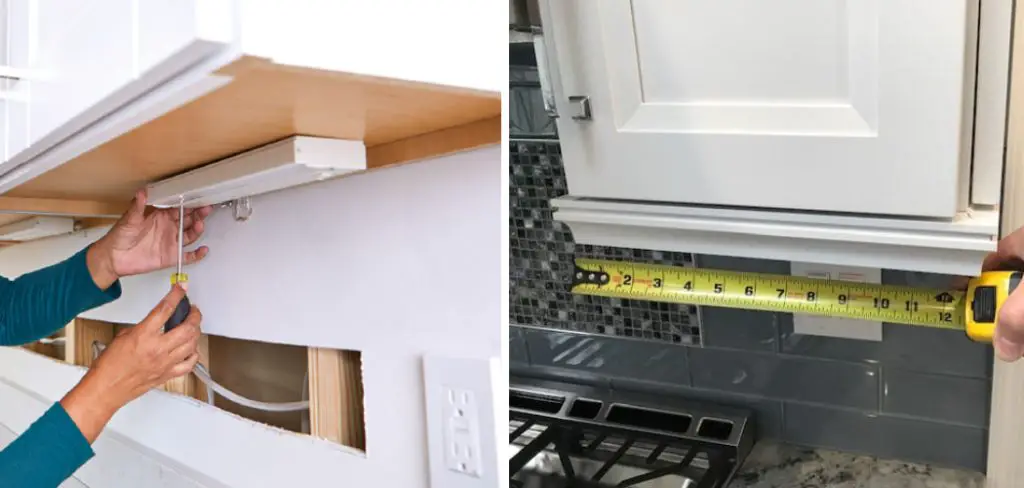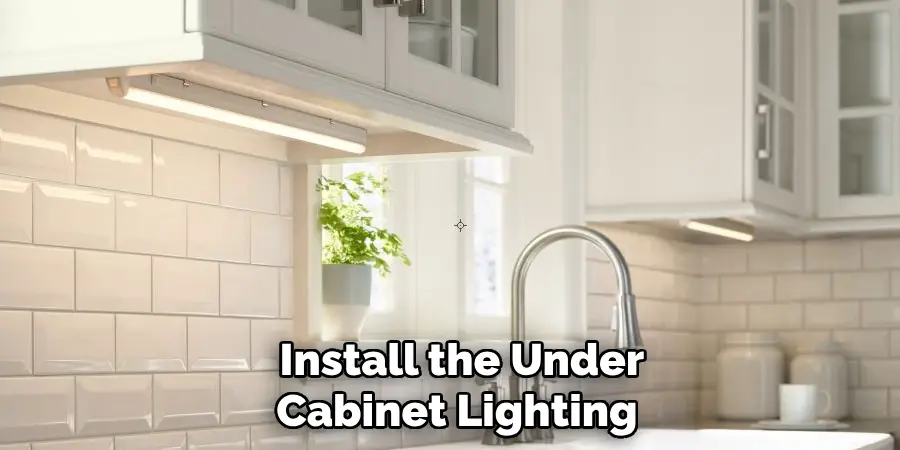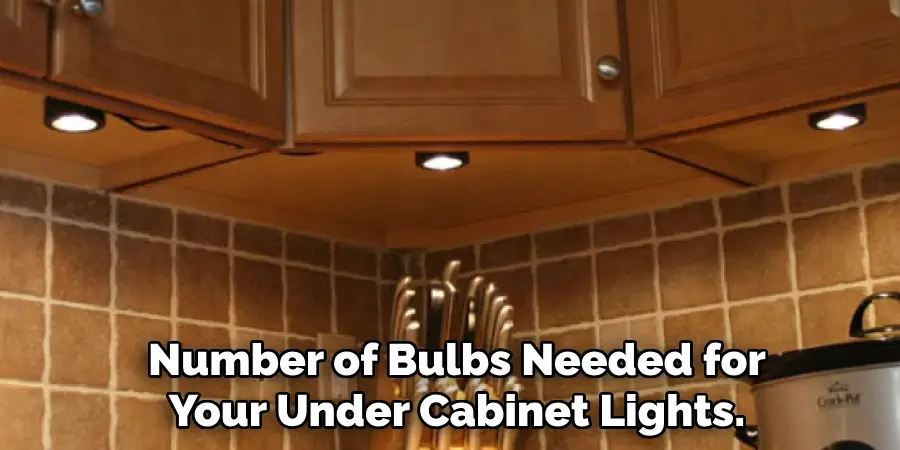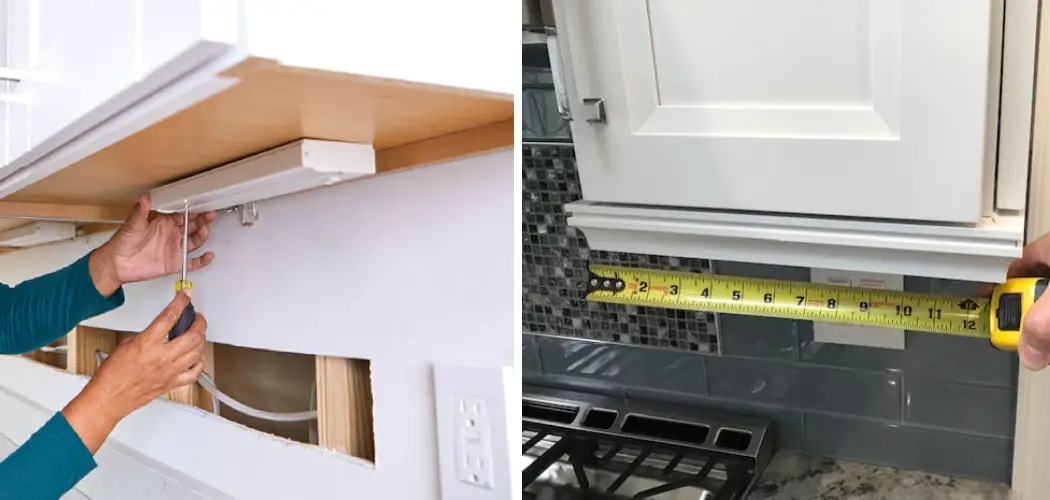Under cabinet lighting is a popular and functional addition to any kitchen, bathroom or workspace. It provides extra task lighting in areas that are typically dimly lit, making it easier to see while prepping food, applying makeup or working on projects. Under cabinet lighting is a popular choice for many homeowners due to its functional and aesthetic benefits.

It provides the perfect amount of task lighting for cooking, cleaning, and other kitchen activities. In addition, it can also enhance the overall look of your kitchen by adding style and warmth. But before you start shopping for under cabinet lighting fixtures, it’s important to know how to measure for them.
Accurate measurements will ensure that you purchase the right size and quantity of lights for your space, saving you time and money in the long run. In this blog post, You will learn in detail how to measure for under cabinet lighting.
Tools You Will Need
- Measuring Tape
- Pencil
- Paper or Notepad
- Calculator
- Ladder (if necessary)
- A Helper (if necessary)
- Painter’s tape or masking tape
- Level
- Phone or camera for taking pictures (optional)
- A good lighting design guide for inspiration (optional)
Step by Step Processes for How to Measure for Under Cabinet Lighting
Step 1: Inspect Your Cabinets
Before starting the measurement process, it’s important to inspect your cabinets and evaluate where you want to install the under cabinet lighting. Determine how many lights you will need and if there are any obstructions that may affect the installation. Take note of any outlets or switch locations as well.

Step 2: Gather Tools and Materials
Make sure you have all the necessary tools and materials listed above before you begin measuring. Having everything you need on-hand will make the process smoother and more efficient. Using a measuring tape, measure the width of your cabinets from end to end. This will give you an idea of how many lights you will need and their length.
Step 3: Determine Lighting Spacing
For even and balanced lighting, it’s recommended to space your lights 12-18 inches apart. You can also use the rule of thumb of one light for every 20 inches of cabinet width. Using the spacing measurement from step 4, determine the length of each light needed. For example, if you want to space your lights 15 inches apart, and your cabinet width is 72 inches, you will need four lights that are at least 15 inches long each.
Step 4: Consider Light Types
There are different types of under cabinet lighting available, such as LED, fluorescent or halogen. Each type has its own spacing and installation requirements. Make sure to research the specific type of light you want to use and adjust your measurements accordingly.
Step 5: Determine Installation Method
Under cabinet lighting can be installed in two ways surface mounted or recessed. Surface mounting involves attaching the lights directly under the cabinet with screws, while recessed installation requires cutting into the cabinet for a more seamless look. Decide which method works best for your space and make adjustments to your measurements if necessary.
Step 6: Measure for Power Source
If you are using plug-in lights, measure the distance from the nearest outlet to determine how much cord length you will need. If installing hardwired lights, measure and mark the location where you plan to install an electrical box. Using your notes and measurements, draw a plan or diagram of where you want to install the lights. This will serve as a guide when shopping for lighting and during installation.

If necessary, take pictures of your cabinets and space to refer back to while shopping or installing the under cabinet lighting. This will also help visualize how the lights will look in your space.
Precautions for How to Measure for Under Cabinet Lighting
- When measuring for under cabinet lighting, it is important to remember that you are dealing with electricity. Therefore, safety should always be your top priority.
- Make sure to turn off the power at the circuit breaker before starting any measurements.
- Use a non-contact voltage tester to check if there is still current flowing in the wires.
- Always wear insulated gloves when handling any electrical equipment.
- Do not touch any metal parts while the power is still on.
- If possible, have someone assist you when taking measurements.
- Keep all tools and equipment away from water sources to avoid electrocution.
Accurate measurements are essential for a successful installation of under cabinet lighting. But safety should always come first. Follow these precautions to ensure that you can safely measure for under cabinet lighting.
Importance of Measure for Under Cabinet Lighting
When it comes to lighting, measuring for under cabinet lighting is often overlooked. However, this step is crucial in ensuring that your space is properly illuminated and functional. Here are reasons why measuring for under cabinet lighting is important:
1. Proper Fit
Measuring allows you to get the exact dimensions needed for your under cabinet lights. This ensures a proper fit and prevents any gaps or overlaps. A proper fit also ensures that the lights will be evenly spaced, providing optimal lighting for your space.
2. Electrical Safety
Measuring helps determine the placement of electrical outlets and wiring for your under cabinet lights. This is important because you need to ensure that there is enough space between the light fixtures and any electrical outlets or wires, avoiding potential hazards.
3. Design Aesthetics
Measuring allows you to have a better idea of how the lighting will look in your space. You can determine the best placement and positioning for your under cabinet lights, ensuring they are aesthetically pleasing and complement your overall design.
4. Functionality
Properly measuring for under cabinet lighting also ensures that the light fixtures won’t interfere with any cabinet doors or drawers. This ensures that your space remains functional and easy to use.
5. Cost-Effective
Measuring helps you determine the exact amount of lighting needed for your space, avoiding any unnecessary purchases. This saves you money in the long run by not overbuying or underbuying lighting fixtures.
6. Energy Efficiency
By measuring, you can also determine the wattage and number of bulbs needed for your under cabinet lights. This allows you to choose energy-efficient options, reducing your overall energy consumption and costs.

It ensures proper fit, electrical safety, design aesthetics, functionality, cost-effectiveness, and energy efficiency. So, next time you plan on installing under cabinet lighting, make sure to take the time to measure for optimal results.
What Are Some Common Mistakes People Make When Measuring for Under Cabinet Lighting?
One of the most common mistakes when it comes to measuring for under cabinet lighting is not considering the type of lighting that will be used. It’s important to know whether you will be using LED, fluorescent, or incandescent lights as they all have different sizes and shapes.
This can greatly affect how you measure for your lighting needs. Another mistake people make is not accounting for the size of the cabinet itself. It’s important to measure not only the length of the cabinet, but also its depth and height. This will help determine how many lights are needed and their placement.
Not measuring for obstacles or obstructions is another common mistake. Make sure to take into account any pipes, electrical outlets, or other objects that may be in the way of your lighting. This can impact where the lights are placed and how many you will need.

When measuring, it’s also important to consider the spacing between each light. Too much distance between each light can result in uneven lighting, while too little may cause shadows or glare. It’s recommended to have a maximum of 18 inches between each light for optimal results.
How Can You Ensure Proper Installation and Alignment of the Lights Based on Your Measurements?
After taking accurate measurements for under cabinet lighting, the next step is to ensure proper installation and alignment of the lights. This is crucial as it can greatly impact the overall look and functionality of your space.
One important consideration when installing under cabinet lighting is the placement of electrical outlets. It’s recommended to have an outlet installed in each corner of the cabinets, or at least every 4 feet along the length of the cabinets.
This will ensure that there are no unsightly cords or wires visible and your lights can be easily plugged in. Additionally, it’s important to decide on the type of lighting you want – whether it be hardwired or plug-in.
Hardwired lighting requires a bit more planning as you’ll need to have an electrician install it, but it provides a cleaner and more permanent look. On the other hand, plug-in lighting is easier to install yourself but may require visible cords and outlets.
What Are the Most Common Methods for Measuring and Marking Where the Lights Will Be Installed?
When it comes to under cabinet lighting, there are a few different methods for measuring and marking where the lights will be installed. These methods can vary depending on personal preference, skill level, and the overall layout of your cabinets.
One common method is to measure from an existing light source, such as an overhead light or a nearby outlet. This can help ensure that the new lighting will be evenly spaced and provide enough light for the area.
Another method is to measure from the bottom of the cabinet. This can be helpful if you want to install lights closer to the countertop or if your cabinets are not level.

However, it may require more precise measurements and adjustments during installation. For those with limited experience, using a template or guide can be a helpful method. This involves creating a paper or cardboard template to help you mark where the lights will be installed. Templates can be especially useful for curved or angled cabinets.
Conclusion
Although measuring for under cabinet lighting is a relatively simple process, there are some potential disadvantages to be aware of. One key disadvantage is that the measurements may not always be entirely accurate due to human error or slight variations in the surfaces being measured. This can lead to lights not fitting properly, which can be frustrating and time-consuming to fix.
In conclusion, under cabinet lighting is a great addition to any kitchen or workspace. It provides both functionality and aesthetic appeal, making it a valuable investment for any homeowner or business owner. To ensure the perfect fit and installation of under cabinet lighting, it is crucial to measure accurately. In this blog post, we have covered all the essential steps on how to measure for under cabinet lighting.

